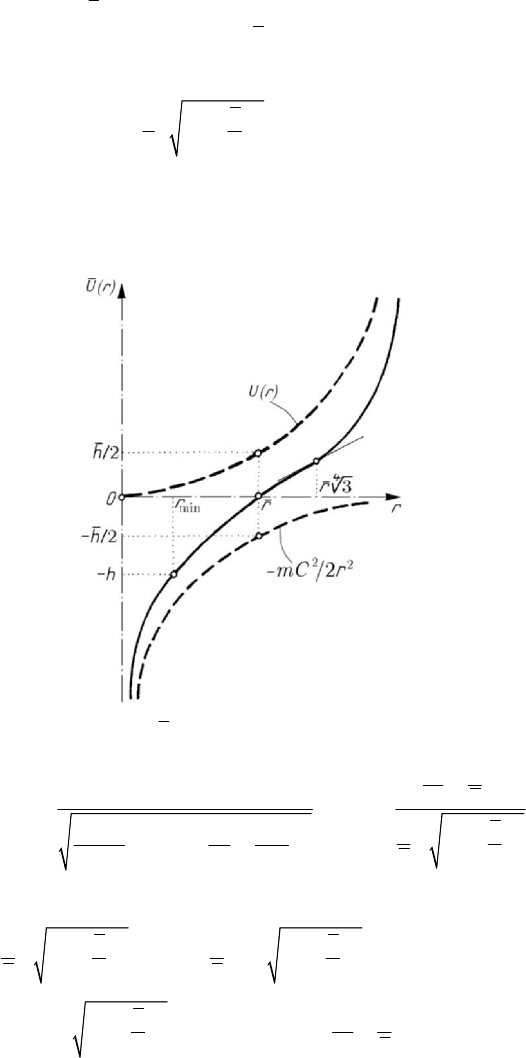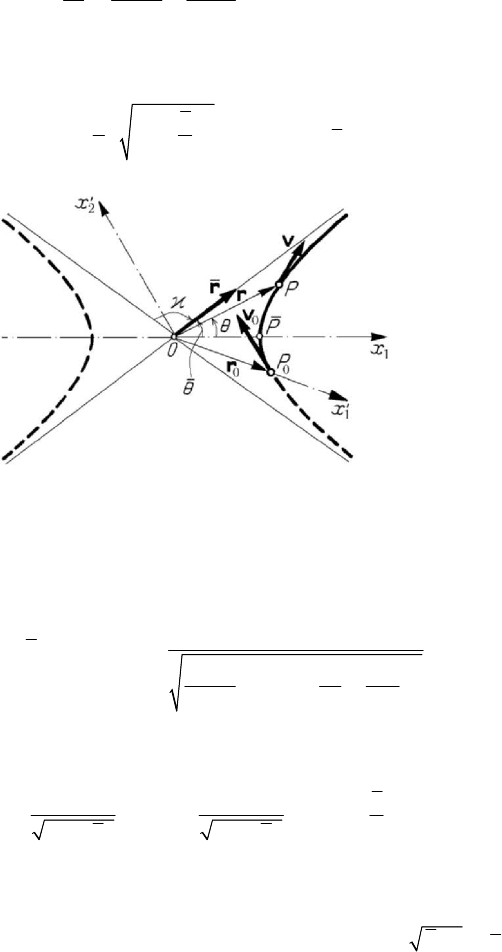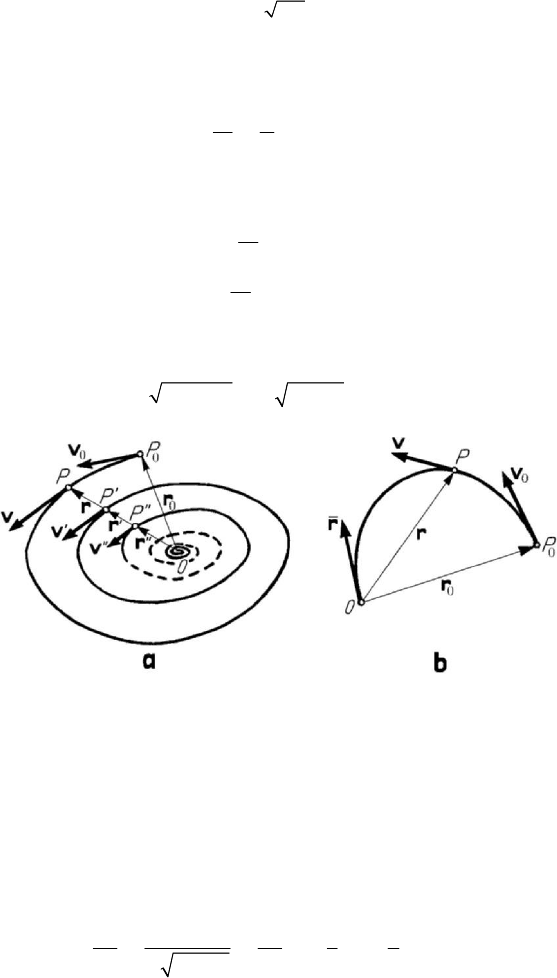Teodorescu P.P. Mechanical Systems, Classical Models Volume I: Particle Mechanics
Подождите немного. Документ загружается.


MECHANICAL SYSTEMS, CLASSICAL MODELS
482
orbit for which
max
min
rrr≤≤ . To
max
min
rr r
=
= corresponds
max
U
; noting that
22 2
/2 /2mC r kr= , because
(
)
(
)
22 2
/2 /2mC r kr
2
/4mC k=
const
=
, it results
Ch
r
k
ω
==
,
2
hmC Ckmkrω== =,
(8.2.3')
where we took into account (8.2.3) and we assumed that the motion takes place in the
positive sense of the angle
θ , so that 0C > . The extreme values of r are the roots of
the equation
[
]
() 2 () / 0rUrhmϕ =+= and are given by
222 2 2
2
max
22 2 2
min
11 11 11
hCmhmkChh
r
kk
mh h h
ω
ω
⎛⎞⎛⎞⎛⎞
=±− =±−=±−
⎜⎟⎜⎟⎜⎟
⎝⎠⎝⎠⎝⎠
,
so that (
2
max
min
rr r= )
2
max
min
11 1 1
2
hhhhh
r
khkhh
⎛⎞
⎛⎞
=±−= +±−
⎜⎟
⎜⎟
⎝⎠
⎝⎠
11
2
rh h
hh
⎛⎞
=+±−
⎜⎟
⎝⎠
,
(8.2.3'')
the annulus which contains the orbit being thus specified.
Figure 8.9. Diagram ()Ur vs
r
, in case of an elastic force of attraction.
The trajectory is given by the relation (8.1.6''); choosing as
1
Ox
-axis the line of one
of the apocentres (
0
0θ =
), we have

Dynamics of the particle in a field of elastic forces
483
()
2
2
max
2
2
1/
22
1/
2
2
22 2
d1/
2 arccos
1
r
r
Ch
h
r
C
hh
hCh
h
mC
h
mC
ω
ρ
θπ
ω
ω
ρ
−
=− = −
⎛⎞ ⎛⎞
−
−− −
⎜⎟
⎜⎟
⎝⎠
⎝⎠
∫
,
where we took into account (8.2.3'), (8.2.3''). Hence, it results
22
2
1cos(2)11 sin
hh h h
hh
hh
ωθπ θ
⎧⎡ ⎤
⎪
⎛⎞ ⎛⎞
−+=+−
⎢⎥
⎨
⎜⎟ ⎜⎟
⎝⎠ ⎝⎠
⎢⎥
⎪
⎩⎣ ⎦
2
2
2
11 cos 1
hCh
h
h
r
θω
⎡⎤⎫
⎪
⎛⎞
+− − − = −
⎢⎥
⎬
⎜⎟
⎝⎠
⎢⎥
⎪
⎣⎦⎭
,
so that the orbit is an ellipse (Bertrand’s theorem is verified for this case) of equation
22
22 2
1cos sin
ra b
θθ
=+
(8.2.3''')
Figure 8.10. Elliptic oscillator.
in polar co-ordinates; the semiaxes are
max
ar
=
and
min
br
=
(Fig.8.10). The
mechanical system formed by a particle acted upon by an elastic force is called elliptic
oscillator.
The motion on the trajectory is specified by the first formula (8.1.6'''), wherefrom
(
0
0t =
)
(
)
22
0
22
1d 1
arctan tan
cos sin
a
t
Cb
ab
θ
ϑ
θ
ω
ϑϑ
==
+
∫
,
where we noticed that
/(/)/(/)Cab hm hkωω
=
= . Taking into account (8.2.3'''),
we get the parametric equations of the elliptic orbit in the form

MECHANICAL SYSTEMS, CLASSICAL MODELS
484
(
)
arctan tan
b
t
a
θω=
,
22 22
cos sinra tb tωω
=
+ .
(8.2.4)
Using the first integral of areas and of mechanical energy, the components of the
velocity are given by
(
)
2
2
Cr
r
r
θω=
,
2
r
v
r
θ
ω
=
,
[]
()
2222 2
00
2
()
r
vr Urh v rr v
m
θ
ω== + = + − −
,
(8.2.4')
where we took into account (8.1.6') and (8.2.3). We observe that the areal velocity is
expressed in the form
/2vΩδ= , where δ is the distance from the pole O to the
tangent to the trajectory at the considered point. Because
constΩ
=
, it results that
max
vv= for
min
rbδ == (at the extremities of the minor diameter), while
min
vv=
for
max
raδ == (at the extremities of the major diameter).
In case of the circular oscillator we have
max
min
rr r r
=
==, θω=
, 0
r
v = ,
0
vv r
θ
ω== ; it results that ω is the angular velocity and the motion is uniform.
Starting from the expression (8.1.2) of the elastic force, we may write the equation of
motion (8.1.1) in the form
2
ω
+
=
rr0,
(8.2.5)
where the pulsation
0ω > is given by (8.2.3). The initial conditions (
0
0t = )
0
(0)
=
rr,
0
(0)
=
vv
(8.2.5')
lead to the solution of the problem in the form
0
0
() cos sintttωω
ω
=+
v
rr
,
(8.2.5'')
00
() cos sintttωω ω
=
−vv r ;
(8.2.5''')
we notice that
00
×= ×rv r v, corresponding to the first integral of areas. The vector
r is a linear combination of the vectors
0
r and
0
v ; hence, the trajectory is a plane
curve, excepting the case in which the cross product mentioned above vanishes (the
vectors
0
r and
0
v are collinear). The trajectory does not pass through the origin
because
≠
r0, t∀ . We notice that
00
/ ω
≤
+rr v , t
∀
, so that all the points of
the trajectory are at a finite distance. Hence, the trajectory is a closed curve, which
surrounds the centre
O , that one being a stable position of equilibrium (the orbit can be
contained in the interior of a circle arbitrarily small, the velocity being arbitrarily small
too); the motion is periodic because the particle returns to the same position
(
()()tT t+=rr) with the same velocity ( ()()tT t
+
=vv), after the same period of
time

Dynamics of the particle in a field of elastic forces
485
2
2
m
T
k
π
π
ω
== .
(8.2.6)
The pole
O
is a centre of symmetry of the trajectory and of the motion, because
(/2)()tT t+=−rr, (/2)()tT t
+
=−vv. The velocity vector is also finite; it is a
continuous function, which is non-zero for all values of
t
, so that the motion takes
place always in the same direction. With respect to a system of oblique co-ordinates
12
Ox x
′′
, specified by the conjugate diameters corresponding to the vector
0
r of the
initial position and to the initial velocity
0
v (Fig.8.10), one obtains the equation of the
ellipse in the form
()
22
12
22
0
0
1
/
xx
r
v ω
′′
+
=
.
(8.2.7)
We notice that
()
222
00 0 0
1
cos 2 sin 2
2
tvr tωωω
ω
⋅= ⋅ + −
rv r v .
Hence, to obtain a circular oscillator (
0
⋅
=rv , t
∀
) it is necessary and sufficient that
the initial conditions verify the relations
00
0
⋅
=rv and
00
vrω
=
.
The number which shows how many times the particle travels through the whole
trajectory in a unit time is called the frequency of the motion and is given by
11
22
k
Tm
ω
ν
ππ
== =
;
(8.2.6')
we notice that the pulsation
2ωπν
=
represents the number of periods in 2π units of
time, the denomination of circular frequency used too being thus justified.
These results may be easily correlate with those previously obtained starting from the
general theory of motion of a particle subjected to the action of a central force. We
observe that one obtains the same results as in the case of small motions of a spherical
pendulum around a stable position of equilibrium.
2.1.2 Case of a repulsive elastic force
In case of the motion around a labile position of equilibrium O , we consider a
repulsive elastic force of the form
verskr k==Frr, 0k > . (8.2.8)
The corresponding apparent potential is
()
22
222222
22
()
22 2
2
kmCm C m
Ur r r r
rr
ωωθ
⎛⎞
=− = − = −
⎜⎟
⎝⎠
,
k
m
ω = ;
(8.2.9)

MECHANICAL SYSTEMS, CLASSICAL MODELS
486
the graphic of this function is represented in Fig.8.11, the radius
r and the
corresponding constant
h , given by the relations (8.2.3'), being put into evidence. In
case of a constant of energy
h for which ()Ur h≥− we obtain a unbounded orbit,
which has a pericentre given by (the positive root of the equation
() 0rϕ = )
2
2
min
11
hh
r
kh
⎡
⎤
⎛⎞
=
+−
⎢
⎥
⎜⎟
⎝⎠
⎢
⎥
⎣
⎦
.
(8.2.9')
We are in the case of Fig.8.6,b, the integrals (8.1.6''), (8.1.6''') being convergent (we
have
min
() ( ) ()rrr rϕψ=− ). Choosing as
1
Ox -axis the line of the pericentre
(
0
0θ = ), the formula (8.1.6'') leads to
Figure 8.11. Diagram ()Ur vs
r
, in case of a repulsive elastic force.
(
)
2
2
min
2
1/
2
1/
2
2
22 2
d1/
2
r
r
C
hCh
mC
mC
ρ
θ
ω
ρ
=−
⎛⎞
+− −
⎜⎟
⎝⎠
∫
2
2
arccos
1
Ch
h
r
hh
h
h
ω
ω
−
=
⎛⎞
+
⎜⎟
⎝⎠
,
where we used the relations (8.2.3'), (8.2.9'). Hence, it results
22
2
1cos2 1 1cos
hh h h
hh
hh
ωθω θ
⎧⎡ ⎤
⎪
⎛⎞ ⎛⎞
+=++
⎢⎥
⎨
⎜⎟ ⎜⎟
⎝⎠ ⎝⎠
⎢⎥
⎪
⎩⎣ ⎦
2
2
2
11sin1
hCh
h
h
r
θω
⎡⎤⎫
⎪
⎛⎞
−+ − −=−
⎢⎥
⎬
⎜⎟
⎝⎠
⎢⎥
⎪
⎣⎦⎭
,

Dynamics of the particle in a field of elastic forces
487
so that the orbit is an arc of hyperbola (Fig.8.12) of equation
22
22 2
1cos sin
ra b
θθ
=−
(8.2.10)
in polar co-ordinates; the semiaxes are given by
22
min
ar= ,
2
2
11
hh
b
kh
⎡
⎤
⎛⎞
=++
⎢
⎥
⎜⎟
⎝⎠
⎢
⎥
⎣
⎦
,
2
ab r
=
.
(8.2.10')
Figure 8.12. Trajectory of a particle acted upon by a repulsive elastic force.
The formulae (8.1.6''') allow then to study the motion of the particle along the
trajectory. We notice that we have to do with a phenomenon of diffraction, where the
angle of diffraction is given by
(
)
2
min
2
0
2
1/
2
2
22 2
d1/
2
r
C
hCh
mC
mC
ρ
πθπ
ω
ρ
=− =−
⎛⎞
+− −
⎜⎟
⎝⎠
∫
,
so that
22 22
arccos arccos arctan
hhh
h
hh hh
π
−
=− = =
++
.
(8.2.10'')
One observes that for
0h <
(hence
0h
−
>
, we are above the
Or
-axis) we have
ba<
and /2π>
, while for
0h >
(hence
0h
−
<
, we are under the
Or
-axis) we
have
ba> and /2π<
. For 0h
=
one obtains /ab hk r
=
== and
/2π=
, the hyperbola being equilateral (rectangular).
In case of the force (8.2.8), the equation of motion (8.1.1) has the form

MECHANICAL SYSTEMS, CLASSICAL MODELS
488
2
ω
−
=
rr0
.
(8.2.11)
If we put the initial conditions (8.2.5'), the solution of the boundary value problem is
given by
0
0
( ) cosh sinhtttωω
ω
=+
v
rr
,
(8.2.11')
00
() cosh sinhtttωω ω=+vv r .
(8.2.11'')
With respect to the system of oblique co-ordinates
12
Ox x
′
′
, determined by the conjugate
diameters which correspond to the vector
0
r of the initial position and to the initial
velocity
0
v (Fig.8.12), it results that the trajectory is an arc of hyperbola of equation
22
12
22
00
1
(/)
xx
rvω
′′
−
= ,
(8.2.12)
the centre
O
being a labile position of equilibrium (the orbit cannot be contained in the
interior of a circle arbitrarily small and the velocity of the particle may increase without
any limit). The particle travels through the trajectory only once without returning to the
initial position. We may write
(
)
0
0
() tanh coshtttωω
ω
=+
v
rr ,
(
)
0
0
() tanh coshtttωω ω
ω
=+
v
vr ;
noting that
lim tanh 1
t
tω
→∞
= , it results that the asymptote to which tends the trajectory
of the particle is specified by the vector
0
0
ω
=+
v
rr
.
(8.2.12')
As in the case of an elastic force of attraction, these results may be easily correlate to
those previously obtained in the frame of the general theory of motion of a particle
subjected to a repulsive central force.
2.1.3 Motion of a particle subjected to the action of an elastic and of a damping
force
Let us suppose that in the motion of a particle subjected to the action of an elastic
force of attraction (8.2.2) intervenes a damping force
versΦ
=
− v
Φ
, tangent to the
trajectory and having a direction opposite to that of the motion. If the magnitude of the
damping force is proportional to the velocity, hence if
k
′
=
−
r
Φ
, 0k
′
> being a
damping coefficient, then the equation of motion becomes
2
2λω
+
+=
rrr0
,
(8.2.13)

Dynamics of the particle in a field of elastic forces
489
with the constant
/2 0kmλ
′
=>. The damping coefficient corresponding to the
relation
ωλ
=
is a critical damping coefficient
c
k
′
; we notice that, in this case (
c
k
′
does not depend on
k
′
),
22
c
km kmω
′
== .
(8.2.14)
We introduce also the non-dimensional damping factor (the damping ratio, the critical
damping fraction)
c
k
k
λ
χ
ω
′
=
=
′
.
(8.2.14')
With the initial conditions (8.1.5'), we get
000
1
() e cos ( )sin
t
tt t
λ
ωλω
ω
−
⎡⎤
′
′
=++
⎢⎥
′
⎣⎦
rr vr
,
(8.2.15)
2
000
1
() e cos ( )sin
t
tt t
λ
ωωλω
ω
−
⎡⎤
′
′
=−+
⎢⎥
′
⎣⎦
vv rv
,
(8.2.15')
where we have introduced the pseudopulsation
22 2
1ωωλωχ
′
=−=−,
(8.2.15'')
Figure 8.13. Damped pseudoelliptic oscillator (a); aperiodic damped motion (b).
assuming that
1χ <
, hence ωλ> (subcritical damping). The damping factor
t
e
λ−
transforms the trajectory which, in the absence of this factor, would be an ellipse in a
spiral (the radius vector diminishes continuously); the particle tends, in an infinite time,
to the origin
O
, with a velocity which tends to zero too (Fig.8.13,a). This mechanical
system is called also damped pseudoelliptic oscillator, the respective motion of the
particle being a pseudoperiodic damped motion. After equal intervals of time of
pseudoperiod
(
)
24
2
22213
1 ...
28
1
T
πππ
χχ
ωω
ωχ
== = + + +
′
−
,

MECHANICAL SYSTEMS, CLASSICAL MODELS
490
the particle reaches the points
P
′
, P
′
′
,…, which are situated on the common support
of the position vectors
′
r
,
′
′
r
,…; the corresponding velocities
′
v ,
′′
v ,… have the
same direction. We observe that
/ / ... e
T
rr rr
λ
−
′′′′
===
, //vv vv
′
′′ ′
=
...=
e
Tλ−
= , obtaining a decrease in geometric progression of ratio e
Tλ
−
of the radius
vector and of the velocity; the number
(
)
35
2
2213
2 ...
28
1
T
πχπλ
δλ πχχ χ
ω
χ
=− =− =− =− + + +
′
−
is called logarithmic decrement (for
1χ we may take 2Tλπχ
−
≅− ), being equal
to
ln( / ) ln( / ) ...rr vv
′′
==.
If
1χ = , hence if ωλ= (critical damping), then we may write
[
]
000
() e ( )
T
tt
λ
λ
−
=++rrvr,
[
]
000
() e ( )
T
tt
λ
λλ
−
=−+vvvr.
(8.2.16)
The corresponding motion is damped; the trajectory starts from the point
0
P and tends,
in an infinite interval of time, with a velocity which tends to zero, towards the centre
O , which is an asymptotic point (Fig.8.13,b). Noting that we may write
0
00
() e
T
tt
t
λ
λ
−
⎡⎤
=++
⎣⎦
r
rvr
,
0
00
() e ( )
T
tt
t
λ
λλ
−
⎡
⎤
=−+
⎣
⎦
v
vvr
and that we have
lim e 0
t
t
t
λ−
→∞
=
, it results that the tangent at O to the trajectory is
specified by the vector
0
0
λ
=+
v
rr
.
(8.2.16')
If
1χ > , hence if ωλ< (supercritical damping), then we use the notation
22 2
1ωλωωχ
′′
=−= −
(8.2.17)
and obtain
000
1
() e cosh ( )sinh
t
tt t
λ
ωλω
ω
−
⎡⎤
′
′′′
=++
⎢⎥
′′
⎣⎦
rr vr
,
(8.2.17')
2
000
1
() e cosh ( )sinh
t
tt t
λ
ωωλω
ω
−
⎡⎤
′
′′′
=−+
⎢⎥
′′
⎣⎦
vv rv
.
(8.2.17'')
Noting that we can write
000
1
( ) e cosh ( )tanh
t
tt t
λ
ωλω
ω
−
⎡
⎤
′
′′′
=++
⎢
⎥
′′
⎣
⎦
rrvr
,

Dynamics of the particle in a field of elastic forces
491
2
000
1
( ) e cosh ( )tanh
t
tt t
λ
ωωλω
ω
−
⎡
⎤
′
′′′
=−+
⎢
⎥
′′
⎣
⎦
vvrv
and that
()
()
2
1
lim e cosh lim e 1 e 0
2
ttt
tt
t
λλωω
ω
′′ ′′
−−−−
→∞ →∞
′′
=+=
,
lim tanh 1
t
tω
→∞
′′
=
,
it results that the trajectory of the particle has the same form as in the previous case
(Fig.8.13,b); the tangent at the asymptotic point
O will be specified by the vector
000
1
()λ
ω
=+ +
′′
rr v r.
(8.2.17''')
Hence, the corresponding motion is strongly damped. We can say that both last
considered cases are aperiodic damped motions.
Figure 8.14. Aperiodic damped motion of a particle acted upon by a repulsive elastic force.
If the elastic force is repulsive, of the form (8.2.8), then the apparition of a damping
force the modulus of which is proportional to the velocity leads to the equation of
motion
2
2λω
+
−=
rrr0;
(8.2.18)
the initial conditions (8.2.5') lead to
000
1
() e cosh ( )sinh
t
tt t
λ
ωλω
ω
−
⎡⎤
=++
⎢⎥
⎣⎦
rr vr
,
(8.2.18')
2
000
1
() e cosh ( )sinh
t
tt t
λ
ωωλ ω
ω
−
⎡⎤
=+−
⎢⎥
⎣⎦
vv rv
,
(8.2.18'')
with the notation
22 2
1ωλωω χ=+=+.
(8.2.18''')
We observe that
